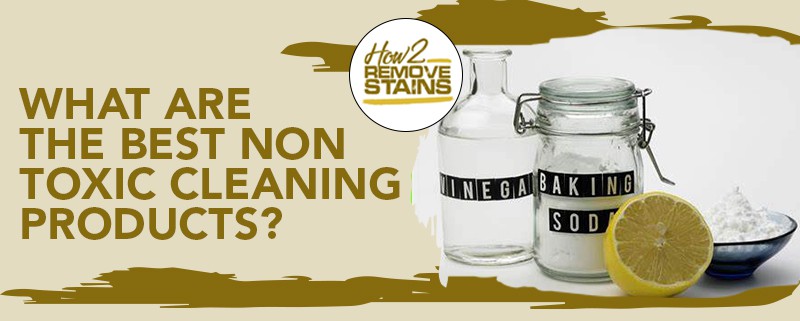The best non-toxic cleaning product is made up of 2 ounces of baking soda, 4 ounces of white vinegar mixed into ½ gallon of water with a little lemon or orange for aroma. This cleaning product can be used for windows, showers, bathroom mirrors, and other soiled surfaces.
Sprinkle the mixture, and get scrubbing with a cloth or brush!
Although many brands claim that their cleaning products are organic and natural, it takes a lot of knowledge to differentiate between the products that contain toxic substances and the products that are completely environmentally friendly.
Sometimes the list of ingredients on the back of store-bought cleaning products doesn’t even list every single ingredient used. Fortunately, you can make a non-toxic cleaner yourself. It is a very easy process, and it is backed by science and green-living experts too!
Table of Contents
All-purpose cleaner: baking soda and vinegar
Making a non-toxic cleaner is very simple. All you need is to mix three ingredients and then get to work.
The ingredients:
- 2 ounces of baking soda
- 4 ounces of vinegar
- ½ gallon of water
Optionally, you can add the juice of citrus fruits (lemon, lime or orange) for a refreshing aroma.
If you want to make a bigger or smaller amount of cleaner, make sure that the ratio is always kept at 1 part baking soda to 2 parts vinegar for it to be most effective.
The procedure:
- Obtain a new or recently washed 2-liter (half gallon) container.
- Pour 2 ounces of baking soda and 4 ounces of vinegar into the water.
- Add 3 tablespoons of lemon juice.
- Stir the mixture to mix ingredients and remove lumps.
- Label the container.
Using the cleaner in your bathroom:
- Put mixture inside a squirt bottle
- Squirt some cleaner on the bathroom surface.
- Scrub the surface with a brush, cloth, or sponge.
- Rinse the surface with water.
For carpet cleaning:
Use the same ingredient ratio of vinegar and baking soda, without the water added to it. Ensure that you have a paste-like consistency.
- Apply the paste to carpet stain
- Allow the paste to dry overnight
- Vacuum up any residue
For drain cleaning:
The reaction of vinegar and baking soda is explosive. Many bubbles are created. This comes in handy with stubborn, slow drains.
- Pour 2 ounces of baking soda and 4 ounces of vinegar into your drain.
- Let the bubbly reaction finish and clear out the gunk in your drain.
- Pour hot water into the drain until the mixture is thoroughly flushed.
Other non-toxic cleaners to use in your home
Vinegar disinfectant
Vinegar is an appropriate substitute for bleach. It can be used to clean windows, walls, kitchen utensils, and many other surfaces without fear of toxic contaminants. You’ll need:
- 5% Vinegar solution
- Essential oil
- Distilled water
Follow these steps:
- Use a clean spray bottle made of glass
- Create a mixture of water and vinegar in equal proportions of 1:1
- Add a few drops of essential oil
- Let disinfectant rest for 30 minutes before use
- Spray on surfaces to get rid of grime and germs.
Polish and floor cleaner
You can also use vinegar combined with water and oil as an effective way to clean and polish floors. The approach you use varies slightly depending on the floor’s surface material.
Wood floors
Use one-quarter cup of vinegar in 2 liters of warm water to remove grime from wooden floors. You can then polish your floor with 1:1 vinegar and vegetable oil.
If the floor is damp, equal amounts of water and vinegar can be used to clean it. Pure peppermint oil can be added to the vinegar and water, shaken, and mixed well to add a pleasant scent.
Linoleum and vinyl
A few drops of olive oil and 1 cup of vinegar should be mixed into 1 gallon of warm water, and used for cleaning linoleum and vinyl.
Stone and brick
Mix one cup of vinegar into one gallon of warm water and pour it on the tiles and bricks, scrubbing with a hard-bristled brush. Rinse with tap water.
Painted wood
1 teaspoon of baking soda stirred into 1 gallon of hot water can be used to clean painted wood.
Furniture polish
Put 4-5 drops of essential oil into ½ a cup of warm water. Stir well. Put a few drops on a cotton cloth, and use it to clean furniture.
Unvarnished wood
Mix 3 teaspoons of lemon juice and 2 teaspoons of olive oil. Spray mixture onto a cotton cloth, scrunching it to spread the mixture. Apply to clean the furniture in wide strokes.
Non-toxic alcohol for cleaning
Alcohols are usually used as disinfectants and as antibacterial agents. Not all alcohol is harsh or toxic for your lungs and skin. Here are a couple non-toxic options:
- Isopropyl Alcohol: Use it alone or mix with water
- Ethyl Alcohol: Use alone or mix with water. Vodka can also be used as it is essentially ethyl alcohol.
- Hydrogen Peroxide: Use alone or mix with water
Essential oils for cleaning
Essential oils can be used for cleaning because they have antimicrobial and disinfectant properties. Multiple essential oils can be mixed to clean. Read more about cleaning with essential oils here.
These are a few examples of essential oils that are great for cleaning:
- Tea tree oil
- Peppermint
- Lavender
- Rosemary
FAQs about non-toxic cleaners
Do baking soda and vinegar homemade cleaners actually work?
Homemade cleaners made from baking soda and vinegar are highly effective! Vinegar dissolves grease and deposits from minerals. It washes off mildew, polishes brass, cleans stainless steel, and cleanses water spots.
Baking soda balances out the acidic nature of vinegar. It cleans shiny materials without corroding them and polishes aluminum, jewelry, porcelain, and tiles – making them look new again.
Are essential oils green products?
Yes. Essential oils are extracted by distilling stems, flowers, and leaves. They are very concentrated, so a few drops are enough. They smell wonderful and have anti-bacterial, antifungal, and antimicrobial properties. They can be found in many health food stores or in online stores.
Is it okay to mix homemade cleaning products?
Although these products are non-toxic, you should follow instructions when making homemade cleaners, for the most effective and safe cleaning in your household. Make sure that all your DIY products are well-labeled to avoid confusion and accidents.
Final thoughts
The best cleaning products are those that are homemade. A baking soda and vinegar mix is the easiest non-toxic cleaner to make – it has stood the test of time. It is much safer than commercially produced cleaners with toxic chemicals that may cause adverse effects to you or your family.


